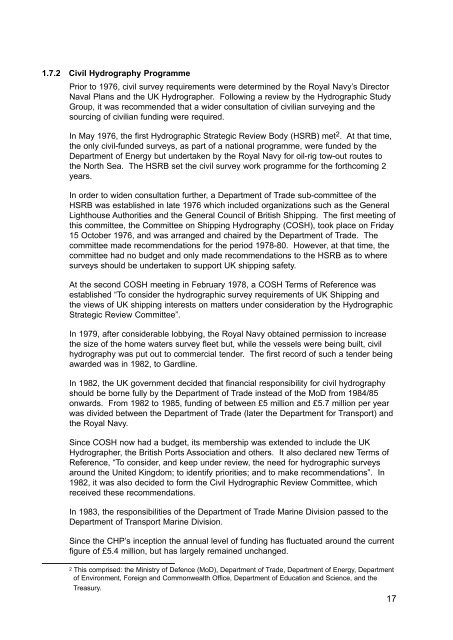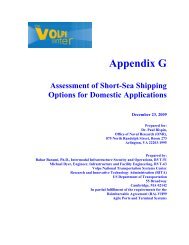Octopus Harald - Marine Accident Investigation Branch
Octopus Harald - Marine Accident Investigation Branch
Octopus Harald - Marine Accident Investigation Branch
Create successful ePaper yourself
Turn your PDF publications into a flip-book with our unique Google optimized e-Paper software.
1.7.2 Civil Hydrography ProgrammePrior to 1976, civil survey requirements were determined by the Royal Navy’s DirectorNaval Plans and the UK Hydrographer. Following a review by the Hydrographic StudyGroup, it was recommended that a wider consultation of civilian surveying and thesourcing of civilian funding were required.In May 1976, the first Hydrographic Strategic Review Body (HSRB) met 2 . At that time,the only civil-funded surveys, as part of a national programme, were funded by theDepartment of Energy but undertaken by the Royal Navy for oil-rig tow-out routes tothe North Sea. The HSRB set the civil survey work programme for the forthcoming 2years.In order to widen consultation further, a Department of Trade sub-committee of theHSRB was established in late 1976 which included organizations such as the GeneralLighthouse Authorities and the General Council of British Shipping. The first meeting ofthis committee, the Committee on Shipping Hydrography (COSH), took place on Friday15 October 1976, and was arranged and chaired by the Department of Trade. Thecommittee made recommendations for the period 1978-80. However, at that time, thecommittee had no budget and only made recommendations to the HSRB as to wheresurveys should be undertaken to support UK shipping safety.At the second COSH meeting in February 1978, a COSH Terms of Reference wasestablished “To consider the hydrographic survey requirements of UK Shipping andthe views of UK shipping interests on matters under consideration by the HydrographicStrategic Review Committee”.In 1979, after considerable lobbying, the Royal Navy obtained permission to increasethe size of the home waters survey fleet but, while the vessels were being built, civilhydrography was put out to commercial tender. The first record of such a tender beingawarded was in 1982, to Gardline.In 1982, the UK government decided that financial responsibility for civil hydrographyshould be borne fully by the Department of Trade instead of the MoD from 1984/85onwards. From 1982 to 1985, funding of between £5 million and £5.7 million per yearwas divided between the Department of Trade (later the Department for Transport) andthe Royal Navy.Since COSH now had a budget, its membership was extended to include the UKHydrographer, the British Ports Association and others. It also declared new Terms ofReference, “To consider, and keep under review, the need for hydrographic surveysaround the United Kingdom; to identify priorities; and to make recommendations”. In1982, it was also decided to form the Civil Hydrographic Review Committee, whichreceived these recommendations.In 1983, the responsibilities of the Department of Trade <strong>Marine</strong> Division passed to theDepartment of Transport <strong>Marine</strong> Division.Since the CHP’s inception the annual level of funding has fluctuated around the currentfigure of £5.4 million, but has largely remained unchanged.2 This comprised: the Ministry of Defence (MoD), Department of Trade, Department of Energy, Departmentof Environment, Foreign and Commonwealth Office, Department of Education and Science, and theTreasury.17
















